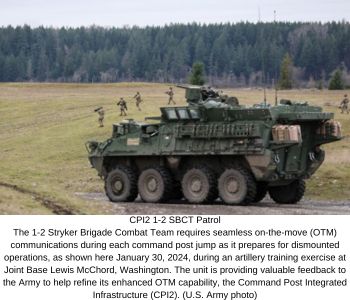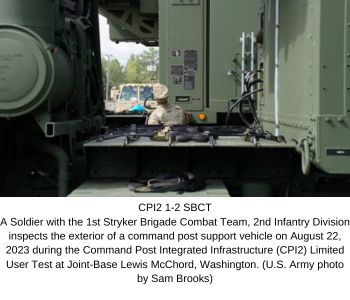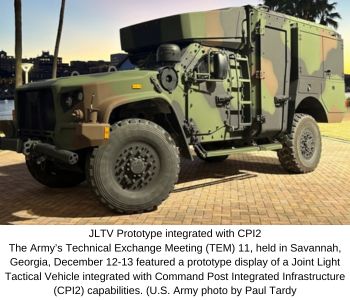SAVANNAH, Ga. — Army leaders understand that preparing for large scale combat operations will require commanders to lead on the move with the ability to disperse at a moment’s notice.
Leaders also understand that one size will not fit all for command posts under this new paradigm.
At the Army’s Network Technical Exchange Meeting (TEM) in December 2023 in Savannah, Georgia, a panel discussion on command post modernization unveiled plans for CPI2 Next, which is the latest in a series of efforts to modernize existing vehicle-based Command Post Integrated Infrastructure (CPI2) units and provide on-the-move command and control in anticipation of future combat scenarios.
The CPI2 program is integrating network and communications technologies into a variety of vehicle platforms, then fielding them incrementally to units for experimentation and feedback, which will inform future iterations.
While current iterations of integrated command post platforms have proved useful in the field during unit experimentation, a Limited User Test (LUT) with the 1st Stryker Brigade Combat Team, 2nd Infantry Division (1-2) at Joint Base Lewis McChord, Washington, conducted this past summer indicated a need for a more adaptable, configurable command post with greater disbursement capability. From this feedback, project managers identified two primary concerns regarding the use of existing Command Post Support Vehicles: a lack of integrated power and insufficient wireless network configuration.

“We have to be able to disperse in a moment’s notice, and anything requiring cables or wires that connect to immobile objects will put Soldiers in harm’s way,” said Lt. Col. Herb Gamble, product manager for CPI2.
To address these concerns, panelists discussed solutions currently identified and solutions they will be seeking from industry partners to meet the Army’s goal for a modular, scalable and survivable command post to support Army of 2030.
Beginning in March, CPI2 program integration teams will begin installing generators onto 1-2 SBCT CPI2-equipped vehicle platforms. These power sources will replace the micro grid initially tested as part of the LUT, which still required the vehicles to be tethered to a power source.
“These generators will open up the option for more rapid displacement and emplacement of mobile command posts each time the tactical operations center jumps to another location within the operational environment,” Gamble said.
Sometime this summer, these power-integrated platforms will accompany the unit to their National Training Center rotation, prior to deploying.
“This will be the first time on-the-move command post capabilities will be part of a combined training center rotation,” Gamble said.
To address the wireless capabilities needed for on-the-move missions, the Army will generate a Request for Information to industry to enhance or replace the current onboard WiFi, which works well in line-of-sight situations but will require more robust capabilities to meet Army command post directive to rapidly move and halt in just minutes.

At the same time, the program continues to innovate, and is currently conducting a pilot that integrates command post capabilities into a Joint Light Tactical Vehicle — this time including the Advanced Field Artillery Tactical Data System to enhance fire support missions on the move.
“We conducted an exercise with the Army’s Test Command this past fall to determine the ability of forward observers to initiate a call for fires missions to the command post headquarters,” said Lt. Col. Jonathan Judy, product manager for Network Integration and Modernization. “In the lab we validated we can do digital calls for fire on a Secure But Unclassified – Encrypted network, then verified those results in the field using real Soldiers and equipment.”
As the program shifts to its next iteration, called CPI2 Next, it will focus on including more flexible integrated command post capabilities.
“Commanders want to be able to have the modularity and the ability to change and adapt based on their mission set,” Gamble said. “No command post will conduct operations the same way, because based on your mission set and where you’re located, you’re going to want customized command post capabilities.”
Providing units with modular A-kits for their vehicles and mission-tailored B-kits for the Soldiers themselves will allow for optimal functionality without sacrificing ability to disperse. These kits contain communications devices that will be swapped out according to mission objectives, making them ideal for widespread dispersal.
“All mobile command post development should incorporate both new and existing technologies, including improved on-the move and voice command capabilities, which allows project managers to update existing units without fully sunsetting their equipment, making it a favorable both practically and fiscally,” Judy said.
The Army will continue to seek innovative solutions to address these and other mobile and flexible command post requirements via requests for information this fiscal year, including the potential for interoperability with Mission Partner Environment services in anticipation of combat operations with allies and partners.
“Make sure you give us your biggest and brightest ideas,” Gamble said to industry TEM 11 attendees. “We owe it to our Soldiers in arms.”

The U.S. Army Program Executive Office Command, Control and Communications-Tactical (PEO C3T) develops, acquires, fields and supports the Army's Unified Network (Tactical and Enterprise) to ensure force readiness in both current missions and potential future large scale combat operations. This critical Army modernization priority delivers resilient terrestrial and satellite communications capabilities to ensure commanders and Soldiers remain connected and informed at all times, even in the most austere and hostile environments. PEO C3T is delivering an integrated Unified Network to regions around the globe, enabling high-speed, high-capacity voice, data and video communications to an Army user base that includes joint, coalition and other mission partners.